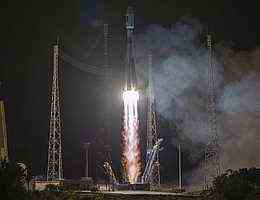With the launch of two more Galileo navigation satellites with a Soyuz launcher from the European space airport in French Guiana on December 5, the largest satellite constellation in Europe has now become even bigger. The Galileo satellites 27 and 28 complete the existing constellation of 26 satellites in orbit and offer the more than 2.3 billion users around the globe the most precise satellite positioning in the world. A press release from the European Space Agency (ESA).
Source: ESA.
December 5, 2021 – The ESA-Director for Navigation, Paul Verhoef, comments: “Today’s launch marks the eleventh launch of operational Galileo satellites in ten years: a decade of hard work by European Galileo partners and European industry, during which Galileo was initially functioning System was established and the first services started in 2016. With these satellites, we are now increasing the robustness of the constellation so that a higher level of service guarantees can be offered. “
The one operated by Arianespace and by the ESA commissioned Soyuz launcher VS-26 lifted off December 5 at 1:19 a.m. CET departed French Guiana with the two 715 kg satellites. All Soyuz stages behaved as planned, with the Fregat upper stage releasing the satellites about 3 hours and 54 minutes after launch into target orbit at an altitude of 23,525 km.

In the coming weeks, the satellites will be steered into their final working orbit at an altitude of 23,222 km with the help of the built-in engines, while their on-board systems will be gradually tested for operational use – this is known as the so-called start-up and early operational phase.
the ESA, which is entrusted with the design, development, procurement, testing and qualification of the Galileo system and the monitoring of its technical development, recently upgraded Galileo’s global ground control segment. This enables the launch and early orbit phase (LEOP) – i.e. the start and early orbit phase – to be controlled by the Galileo operator SpaceOpal in Galileo’s own control center in Oberpfaffenhofen (Germany), and not by an external mission control center the end. The LEOP operations are under the responsibility of the EU Agency for the Space Program (EUSPA) carried out.
“The latest update to the ground control segment enables mission controllers to monitor more Galileo satellites at the same time,” added Pascal Claudel, Chief Operating Officer of EUSPA, responsible for managing Galileo’s operations and delivering services. “This is important because there are many more Galileo starts to come – Galileo has become a constant worldwide, the continuity and technical excellence of which are guaranteed in the long term.”
The satellites launched today are the first two satellites of the remaining 12 first-generation Galileo satellites – an improved version of the existing full operational capability concept. Each of these satellites is powered by OHB Made and tested in Germany, the navigation payloads are from Surrey Satellite Technology Ltd. in the UK and use other components from other European countries.
Before the satellites travel on to French Guiana for launch, they are in the ESTEC-Test center of the ESA in the Netherlands, the largest satellite test center in Europe, subjected to rigorous space flight tests. Six Galileo satellites are currently either in the test phase or are stored on site for transport to South America.
All of the remaining 10 first generation satellites will be launched over the next three years. After that, they will be superseded by the most advanced, powerful and fully reconfigurable navigation satellites ever built. These are called “Galileo Second Generation”.
the ESA is currently developing these G2G satellites together with European industrial companies – from two different consortia to ensure competitiveness and redundancy – and is planning their first launch in 2024.
Matthias Petschke, the responsible director at the European Commission, adds: “Galileo is already delivering results that are accurate to the meter all over the world. However, the Galileo partners are far from resting on their laurels. These two satellites will further advance the Galileo mission and – together with other launches that will follow – enable novel signals and services that will help ensure that the top position of the Galileo mission is maintained in the years to come. “
About Galileo
Galileo is currently the most precise satellite navigation system in the world, used by more than two billion users around the globe.
The full operational phase of the Galileo program is administered and financed by the European Union. The European Commission, the ESA and the EUSPA (the EU-Agency for the Space Program) have signed an agreement under which the ESA as design authority and main contractor for system development on behalf of the Commission, and EUSPA acts as operator and operations manager of Galileo / EGNOS. “Galileo” is registered as a trademark in the database of the European Union Intellectual Property Office (No. 002742237).
About the European Space Agency
The European Space Agency (ESA) is Europe’s gateway to space.
It is an intergovernmental organization founded in 1975 whose mission is to develop European space capabilities and ensure that investment in space benefits citizens in Europe and around the world.
the ESA has 22 member states: Austria, Belgium, Czech Republic, Denmark, Estonia, Finland, France, Germany, Greece, Hungary, Ireland, Italy, Luxembourg, the Netherlands, Norway, Poland, Portugal, Romania, Spain, Sweden, Switzerland and that United Kingdom. Slovenia, Latvia and Lithuania are associate members.
the ESA has a formal collaboration with five member states of the EU recorded. Canada also participates in a cooperation agreement ESAPrograms.
Thanks to the coordination of the financial resources and competencies of its Member States, the ESA Carry out programs and activities that go far beyond the capabilities of a single European country. She also works closely with the in realizing the Galileo and Copernicus programs EU and working closely with Eumetsat in the development of meteorological missions.

